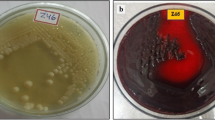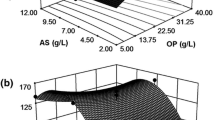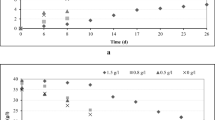Abstract
The present study investigated the use of two-phase olive mill waste (TPOMW) as substrate for the production of exopolysaccharide (EPS) by the endospore-forming bacilli Paenibacillus jamilae. This microorganism was able to grow and produce EPS in aqueous extracts of TPOMW as a unique source of carbon. The effects of substrate concentration and the addition of inorganic nutrients were investigated. Maximal polymer yield in 100-ml batch-culture experiments (2 g l−1) was obtained in cultures prepared with an aqueous extract of 20% TPOMW (w/v). An inhibitory effect was observed on growth and EPS production when TPOMW concentration was increased. Nutrient supplementation (nitrate, phosphate, and other inorganic nutrients) did not increase yield. Finally, an adsorption experiment of Pb (II), Cd (II), Cu (II), Zn (II), Co (II), and Ni (II) by EPS is reported. Lead was preferentially complexed by the polymer, with a maximal uptake of 230 mg/g EPS.




Similar content being viewed by others
Literature Cited
Arjona R, García A, Ollero P (1999) The drying of alpeorujo, a waste product of the olive oil mill industry. J Food Eng 41:229–234
Albuquerque JA, Gonzálvez J, García D, Cegarra J (2004) Agrochemical characterisation of “alpeorujo,” a solid by-product of the two-phase centrifugation method for olive extraction. Biores Technol 91:195–200
Fernández-Bolaños J, Rodríguez G, Rodríguez R, Heredia A, Guillén R, Jiménez A (2002) Production in large quantities of highly purified hydroxytyrosol from liquid-solid waste of two-phase olive oil processing or “alperujo.” J Agric Food Chem 50:6804–6811
Fernández-Bolaños J, Rodríguez G, Gómez E, Guillén R, Jiménez A, Heredia A, et al. (2004) Total recovery of the waste of two-phase olive oil processing: Isolation of added-value compounds. J Agric Food Chem 52:5849–5855
Aragón JM, Palancar MC (2001) Improlive 2000. Present and future of Alperujo. Madrid, Spain, Editorial Complutense, pp 242–300
Ramos-Cormenzana A, Monteoliva-Sánchez M, López MJ (1995) Bioremediation of alpechin. Int Biodeterg Biodegr 35:249–268
Niaounakis M, Halvadakis CP (2004) Olive-mill waste management: Literature review and patent survey. Athens, Greece, Typothito-George Dardanos Publications
Sutherland IW (1998) Novel and established applications of microbial polysaccharides. Trends Biotech 56:265–276
López MJ, Ramos-Cormenzana A (1996) Xanthan production from olive mill wastewaters. Int Biodeterior Biodegradation 38:263–270
Aguilera M, Monteoliva-Sánchez M, Suárez A, Guerra V, Lizama C, Bennasar A, et al. (2001). Paenibacillus jamilae sp. nov., an exopolysaccharide-producing bacterium able to growth in olive-mill wastewater. Int J Syst Bacteriol 51:1687–1692
Geddie L, Sutherland IW (1993) Uptake of metals by bacterial polysaccharides. J Appl Bacteriol 74:467–472
Fiestas Ros de Ursinos JA (1977) Treatment of wastewaters originated in the olive oil industry. Grasas Aceites 28:113–121
López MJ, Moreno J, Ramos-Cormenzana A (2001) The effect of olive-mill wastewaters variability on xanthan production. J Appl Microbiol 90:829–835
Sutherland IW (1990) Biotechnology of microbial exopolysaccharides. Cambridge, UK: Cambridge University Press
Veglio F, Beolchini F, Gasbarro A (1997) Biosorption of toxic metals: An equilibrium study using free cells of Arthrobacter sp. Proc Biochem 32:99–105
Kaplan D, Christian D, Arod S (1987) Chelating properties of extracellular polysaccharide by Zooglea ramigera. Appl Environ Microbiol 53:2953–2956
Norberger A, Enfors S (1982) Production of extracellular polysaccharide by Zooglea ramigera. Appl Environ Microbiol 44:1231–1237
Pagnanelli F, Petrangeli Papini M, Toro L, Trifoni M, Vegliò F (2000) Biosorption of metal ions on Arthrobacter sp.: Biomass characterization and biosorption modelling. Environ Sci Technol 34:2773–2778
Salehizadeh H, Shojaosadati SA (2003) Removal of metal ions from aqueous solution by polysaccharide produced from Bacillus firmus. Water Res 37:4231–4235
Loaëc M, Olier R, Guezennec J (1997) Uptake of lead, cadmium and zinc by a novel bacterial exopolysaccharide. Water Res 31:1171–1179
de Carvalho RP, Chong KH, Volesky B (1995) Evaluation of the Cd, Cu, and Zn biosorption in two-metal systems using an algal biosorbent. Biotechnol Prog 11:39–44
Jang L. K, Nguyen D, Geesey GG (1995) Selectivity of alginate gel for Cu vs Co. Water Res 29:307–313
Acknowledgments
This research was supported by a grant from the Ministerio de Educación y Ciencia and funded under Project No. REN 2000-1502. We also thank our college Lia Wrightsmith, for revising the English text.
Author information
Authors and Affiliations
Corresponding author
Rights and permissions
About this article
Cite this article
Morillo, J.A., Aguilera, M., Ramos-Cormenzana, A. et al. Production of a Metal-Binding Exopolysaccharide by Paenibacillus jamilae Using Two-Phase Olive-Mill Waste as Fermentation Substrate. Curr Microbiol 53, 189–193 (2006). https://doi.org/10.1007/s00284-005-0438-7
Received:
Accepted:
Published:
Issue Date:
DOI: https://doi.org/10.1007/s00284-005-0438-7




